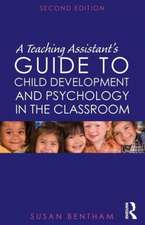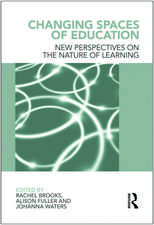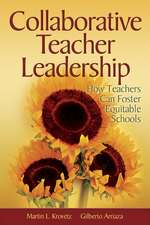Human Resources Administration for Educational Leaders
Autor M. Scott Nortonen Limba Engleză Hardback – 25 iun 2008
A comprehensive and research-based text detailing the important relationship between school administration and human resources administration.
"The author provides [students] with specific strategies for navigating the treacherous waters of personnel selection, development, retention, and removal. I wish I had the book when I began my work as Director of Personnel."
—Zach Kelehear
University of South Carolina
Human Resources Administration for Educational Leaders balances theory and pedagogy to demonstrate the historical evolution of the human resources function in education, the link between human resources and organizational effectiveness, and the new trends in human resources accountability.
Key Features and Benefits:
- Provides students with samples of the tools that practicing HR administrators use for planning, recruiting, interviewing, selecting, evaluating, compensating, and developing staff personnel
- Dedicates separate chapters to areas often neglected in other texts: collective bargaining, human resources responsibility for classified personnel, accountability, and organizational climate and the human resources function
- Features engaging simulations in the form of case studies and critical questions to help students apply the concepts to practice
Instructors' Resources on CD-ROM includes a test bank, sample syllabi, PowerPoint slide presentations, and more. Contact SAGE to request your copy.
Meet the author! http://coe.asu.edu/elps/faculty/norton.php
Preț: 1207.73 lei
Preț vechi: 1654.43 lei
-27% Nou
231.09€ • 241.93$ • 191.22£
Carte tipărită la comandă
Livrare economică 07-21 aprilie
Specificații
ISBN-10: 1412957591
Pagini: 456
Dimensiuni: 178 x 254 x 26 mm
Greutate: 0.96 kg
Ediția:1
Editura: SAGE Publications
Colecția Sage Publications, Inc
Locul publicării:Thousand Oaks, United States
Cuprins
Ch 1. THE HUMAN RESOURCES FUNCTION: ISSUES, CHALLENGES, AND TRENDS
The Human Resources Function in Education: Its Definition
Issues Facing Education and the Human Resources Function
Challenges Facing Education and the Human Resources Function
Selected New Trends in Human Resources Administration
Ch 2. THE HUMAN RESOURCES FUNCTION: AN HISTORICAL PERSPECTIVE
Personnel Administration Before 1900
The Scientific Management Era and Its Impact on Personnel Practices
The Human Relations Era and Its Impact on the Human Resources Function
The Behavioral Science Movement and Its Contributions to the Human Resources Function
The Postmodern Behavioral Science Era
The Human Resources Function and Its Thirteen Processes
The Centralization and Decentralization of the HR Function
Standards of Ethical Administration
Ch 3. THE HUMAN RESOURCES PLANNING PROCESS
Definition and Background of the Human Resources Planning Process
Characteristics of Strategic Human Resources Planning
Evolutionary Stage of a School Organization
Professional Staff Mix
Integrating Human Resources Planning Into the Strategic Plan
Correlation With the System Plan
Information Needs and Forecasting
Policy, Regulation, Processes, and Personnel Changes
Ch 4. STAFFING FOR EDUCATIONAL SERVICES: THE RECRUITMENT PROCESS
An Operations Model for the Recruitment Process
Ch 5. STAFFING FOR EDUCATIONAL SERVICES: THE SELECTION PROCESS
An Operational Model for the Selection Process
Ch 6. THE HR INDUCTION, ASSIGNMENT, STABILITY, AND PROTECTION PROCESSES: TOWARD THE MAXIMIZATION OF HUMAN POTENTIAL
The School as a Social System
Human Motivation Theories
The Human Resources Induction Process
Induction: What the Research Says
The Staff Assignment Process
The Human Resources Stability Process
An Operational Plan for Teacher Retention
Retention of Administrative Personnel
Teacher Absenteeism
The HR Protection Process
Ch 7. THE STAFF DEVELOPMENT AND PERFORMANCE EVALUATION PROCESSES
The Purposes of Staff Development
Trends in Professional Staff Development
Operational Procedures for Staff Development
The Performance Evaluation Process
Ch 8. ORGANIZATIONAL CLIMATE AND THE HUMAN RESOURCES FUNCTION
Organizational Culture and Organizational Climate
The Importance of a Healthy School Climate
The Measurement of School Climate
Research on School Climate
Improvement of School Climate
Human Resources Responsibilities in the Improvement of School Climate
Ch 9. THE LEGAL WORLD OF HUMAN RESOURCES ADMINISTRATION: POLICY AND REGULATION DEVELOPMENT
Legal Considerations and the Human Resources Function
Summary of Selected Legal Statutes, Including Various Civil Rights Acts, Relating to the Work of the Human Resources Function
The Development of Personnel Policies and Administrative Regulations
How Personnel Policies and Regulations Are Developed
Model for Policy and Regulation Development
The Language of School Policies and Regulations
Ch 10. COLLECTIVE BARGAINING AND THE HUMAN RESOURCES FUNCTION: WORKING WITH EMPLOYEE GROUPS
Employee Unions Defined
Working Relationships: The Human Resources Function and Employee Groups
Collective Bargaining: Definition and Basic Principles
The Two Primary Bargaining Processes
Bargaining by Employee Groups: Historical Perspectives
Collective Bargaining in Education and the Central Human Resources Unit
Collective Bargaining in Education
Determination and Recognition of the Bargaining Unit
Initial Bargaining Procedures and Appropriate Table Strategies
The Contract Agreement
Impact of Collective Bargaining on Education
Ch 11. THE COMPENSATION PROCESS: AN OPERATIONS MODEL
School Finance: The Number One Problem Facing Education
Education Is Big Business
Competition for the Tax Dollar
Operational Model for the Compensation Process
Establishing Administrative Procedures for Implementation of the Compensation Process
Controlling the Compensation Process
Trends in Salary Scheduling: Alternative Compensation Programs
History of the Single Salary Schedule
Three Basic Models of Salary Schedules
Ch 12. THE CLASSIFIED STAFF: AN IMPORTANT HUMAN RESOURCES ADMINISTRATION RESPONSIBILITY
The Director of Classified Personnel
The Classified Job Analysis
Job Grading and Salary Ranges
Recruitment of Classified Personnel
Appraising Candidates in Relation to the Selection Criteria
Classified Employee Selection Process
Assessing the Classified Employee Selection Process
The Classified Employee Training Program
Employee Evaluation
Controlling Classified Employee Development Results
Glossary
Index
Notă biografică
Dr. M. Scott Norton, a former public school teacher, coordinator of curriculum, assistant superintendent, and superintendent of schools, received his Ph.D. in Educational Administration and Supervision from the University of Nebraska, Lincoln, where he later served as a professor in and vice-chair of the same department. He then became a professor and chair of the Department of Educational Administration and Supervision at Arizona State University, where he is currently professor emeritus. He teaches graduate classes in human resources administration, the school superintendency, the school principalship, educational leadership, and competency-based administration.
Dr. Norton is co-author of college textbooks in the areas of human resources administration, the school superintendency, and administrative management and author of a textbook in the area of effective leadership for effective administration. He has published widely in national journals in such areas as teacher retention, organizational climate, teacher workload, the department chair in educational administration, employee assistance programs, selection and recruitment practices, the school principalship, distance education and others.














